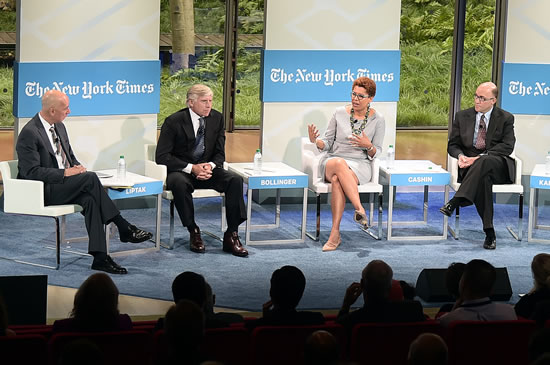Schools For Tomorrow: Outstanding Conference at the New York Times
By James Clark

The New York Times recently held its fourth annual Schools For Tomorrow conference featuring leaders and innovators in the education world. Not since Thomas Jefferson dined alone in the White House has there been such an assemblage of brilliance in one room. The topics covered were the value of assessments, community colleges vs. four-year colleges, how to get college-ready, globalization of education, financing of education, and technology and education.
Some amazing facts were underscored: only 100 colleges have a 75 percent graduation rate. Vassar President Catherine Hill said 40 percent of students are rejected because of the lack of money. A solution was proposed by Florida University President Bernie Machen who explained that at his college, 300 students are subsidized by alumni. Students with need come to student funding dinners; people give money, “I take it for the students.” He continued, “need-based financial aid will solve problems. However, there is not enough money being contributed.” Some speakers underscored that the federal government should have a larger role in helping education. Over 7,000 kids a day drop out of high school!
International students were discussed at great length. University of Minnesota President Eric Kaler said we now have 800,000 international students in the US; they come here for diversity and quality of education. International students pay their own way. They help the local economy by spending money in local stores. China is the largest sending country as well as the largest receiving country. Kaler explained that the first Chinese student arrived in Minnesota in 1914. There are now 5,000 international alumni! Seoul, Korea has a Minnesota project that contains 48 percent of all international undergraduates from the University of Minnesota in the college of science and engineering. Kaler added that since 2004, University of Minnesota international undergraduate enrollment has quadrupled.
President of University of California (UC) Janet Napolitano stressed the importance of research in education and college. “The trend today is that we have moved from Bell labs to the Berkeleys,” said Napolitano. “University of California has 58 Nobel Prize winners and our universities provide the biggest hope for the future.” She said, “The future belongs to thinkers and innovators.” At UC 30 percent of students come from community colleges. We need to streamline the system that permits entry from a community college to a four-year university.
President of Southern New Hampshire University, Paul Leblanc, discussed how we can make a traditional classroom into an online course. Western Governors University President Robert Mendenhall felt that online courses have not fundamentally changed education. “The cost is high, it is not a great learning experience, and you don’t know who is taking the test.” He added, “Higher education will look the same in 10 years as it does today.”
Among the education technology start ups the following were featured Matthew Pittinsky, C.E.O. of Parchment; Ben Wallerstein, co-founder of Whiteboard advisors; Zakiya Smith, strategy director at the Lumina Foundation all spoke about new technology and startup companies to enhance education. John Katzman, founder of Princeton Review introduced his new education search engine, Noodle. Noodle will allow browsers to find a school compatible with their interest, test scores and GPA.
In another session, Who Finishes College, a panel including University of Texas Vice Provost David A. Laude; C.E.O. of OneGoal Jeff Nelson; and Kipp Academy Teacher Catherine Ntube discussed financial, psychological and academic struggles when graduating college. Ntube herself mentioned the obstacles she faced coming from a lower socio-economic background in college. She said it caused her to feel isolated and unhappy even when the university was giving her financial support
Affirmative action was also discussed. President of Columbia Lee C. Bollinger argued for race based affirmative action. However, another panelist Georgetown University Law professor and author of Place Not Race Sheryll Cashin, argued that affirmative action should benefit students who come from lower socio-economic conditions and schools. She argued that underserved students from poor socio-economic locations should be a focal point in college admissions. #
